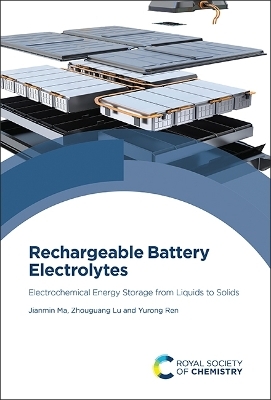
Rechargeable Battery Electrolytes
Electrochemical Energy Storage from Liquids to Solids
Seiten
2024
Royal Society of Chemistry (Verlag)
978-1-83916-737-9 (ISBN)
Royal Society of Chemistry (Verlag)
978-1-83916-737-9 (ISBN)
This book will cover all the major ion-battery groups and their electrolytes. It is suitable for all levels of students and researchers who want to understand the fundamentals and future challenges of developing electrolytes.
Rechargeable batteries are one of the crucial ways we are going to solve the sustainable energy crisis. Lithium-ion batteries have been commercialised and are heavily relied upon, however, the scarcity of lithium resources increases the production cost and hinders further application. Additionally, the toxic and flammable electrolyte brings many potential safety hazards including environmental pollution. Looking for low-cost, safe, and environmentally friendly alternatives to LIBs has become a valuable research direction.
The modification of batteries is focused on the anode, the cathode and electrolyte. Globally, researchers have moved onto new rechargeable batteries based on multivalent metal ions which have been extensively studied, including K+, Ca2+, Mg2+ and Al3+. However, the electrolyte is a very important component of a battery as its physical and chemical properties directly affect the electrochemical performance and energy storage mechanism.
Finding and selecting an appropriate electrolyte system is a crucial factor that must be taken into account to make these post-lithium-ion batteries commercially viable. Until now, it has been challenging to develop a suitable electrolyte with a wide electrochemical stability window and stable anode interface.
This book covers all the major ion-battery groups and their electrolytes, examining their performance and suitability in different solvents: aqueous, non-aqueous, solid gel and polymer.
It is suitable for all levels of students and researchers who want to understand the fundamentals and future challenges of developing electrolytes.
Rechargeable batteries are one of the crucial ways we are going to solve the sustainable energy crisis. Lithium-ion batteries have been commercialised and are heavily relied upon, however, the scarcity of lithium resources increases the production cost and hinders further application. Additionally, the toxic and flammable electrolyte brings many potential safety hazards including environmental pollution. Looking for low-cost, safe, and environmentally friendly alternatives to LIBs has become a valuable research direction.
The modification of batteries is focused on the anode, the cathode and electrolyte. Globally, researchers have moved onto new rechargeable batteries based on multivalent metal ions which have been extensively studied, including K+, Ca2+, Mg2+ and Al3+. However, the electrolyte is a very important component of a battery as its physical and chemical properties directly affect the electrochemical performance and energy storage mechanism.
Finding and selecting an appropriate electrolyte system is a crucial factor that must be taken into account to make these post-lithium-ion batteries commercially viable. Until now, it has been challenging to develop a suitable electrolyte with a wide electrochemical stability window and stable anode interface.
This book covers all the major ion-battery groups and their electrolytes, examining their performance and suitability in different solvents: aqueous, non-aqueous, solid gel and polymer.
It is suitable for all levels of students and researchers who want to understand the fundamentals and future challenges of developing electrolytes.
Introduction to Electrolytes for Rechargeable Batteries;Aqueous and Non-aqueous Electrolytes for Li-ion Batteries;Aqueous and Non-aqueous Electrolytes for Na-ion Batteries;Electrolytes for K-, Ca-, Mg-, and Al-ion Batteries;Aqueous and Non-aqueous Electrolytes for Zn-ion Batteries;Solid Electrolytes for Lithium Batteries;Na-ion Solid Electrolytes for Solid-state Batteries;Ionic Liquid-based Electrolytes for Rechargeable Batteries;Polymer Electrolytes for Rechargeable Batteries;High-concentration Electrolytes for Rechargeable Batteries
| Erscheinungsdatum | 15.02.2024 |
|---|---|
| Verlagsort | Cambridge |
| Sprache | englisch |
| Maße | 156 x 234 mm |
| Gewicht | 682 g |
| Themenwelt | Naturwissenschaften ► Chemie ► Physikalische Chemie |
| Technik ► Elektrotechnik / Energietechnik | |
| Technik ► Umwelttechnik / Biotechnologie | |
| ISBN-10 | 1-83916-737-8 / 1839167378 |
| ISBN-13 | 978-1-83916-737-9 / 9781839167379 |
| Zustand | Neuware |
| Haben Sie eine Frage zum Produkt? |
Mehr entdecken
aus dem Bereich
aus dem Bereich
Quantenmechanik | Spektroskopie | Statistische Thermodynamik
Buch | Softcover (2024)
De Gruyter (Verlag)
59,95 €
Set aus Lehrbuch und Arbeitsbuch
Buch | Hardcover (2022)
Wiley-VCH (Verlag)
109,00 €
Thermodynamik | Kinetik | Elektrochemie
Buch | Softcover (2024)
De Gruyter (Verlag)
59,95 €


